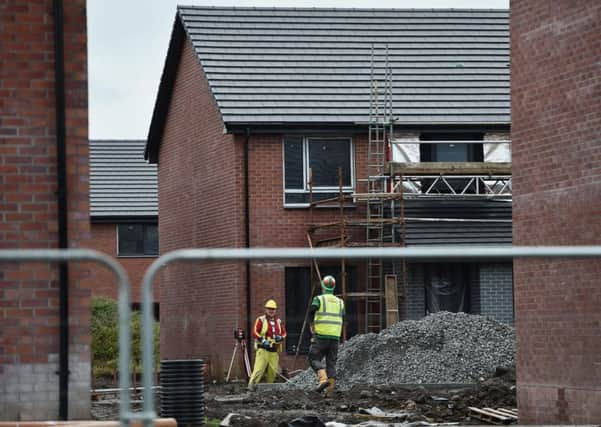Bill Jamieson: Rewritten history widens the credibility gap


The improvement is ascribed to “newly updated data and methodological improvements”.
On an annual basis, Scotland’s growth rate is now just above the UK’s, at 1.3 per cent, compared with 1.2 per cent. This was mainly driven by an increase in output across the services and production sectors.
Advertisement
Hide AdAdvertisement
Hide AdCheerful news, indeed. But there are other revisions, and these are not so cheerful. Previous figures for the construction sector have been revised sharply downwards and the industry continues to experience falls in output, with GDP also remaining below historical growth trends.
Indeed, the revisions on construction are so substantial as to leave us unsure what to make of official numbers. Previous assertions of construction sector output growth of 18 per cent in 2015 have been chopped to six per cent, with knock-on impacts in other years. For example, back in 2016 the estimated growth in the construction sector over 2014 and 2015 was 34 per cent. It is now reckoned at just six per cent.
These are massive downgrades that cannot be brushed aside as lumpy contract completions or seasonal adjustments. How can the figures be so variable? And what credence can we place on the latest estimates from Scottish Government numbers? It all seems so capricious. To adapt the mischievous quip of Groucho Marx, “Those are my figures, and if you don’t like them… well, I have others.”
The result of these revisions is that Scotland’s growth numbers overall for both 2015 and 2014 have been revised down by 1.1 per cent and 0.8 per cent respectively. And our growth rate since 2010 remains poor, averaging around one per cent a year – actually slightly worse than before.
It is not the first time questions have been raised about the accuracy of construction sector numbers. Both the Fraser of Allander Institute, and the independent economist, Professor John McLaren, cast a sceptical spotlight when these figures were first unveiled – and continued to query them when they were repeated.
No public response from the Scottish Government was forthcoming. Now come truly massive revisions. How can we absorb the slashing of sector estimates for 2014 and 2015 from growth of 34 per cent to just six per cent without question? Once again, our economic history is being re-written, making reliable analysis of performance all the more uncertain and erratic.
“Clearly, such an error is worrying,” writes McLaren. “The government statisticians, have, unsurprisingly, changed their methodology for estimating construction output. However, it remains a concern that the alarm bells set off by these figures did not result in quicker action being taken over the two years since such vastly inflated estimates were originally made… Such large and late revisions make it difficult to seriously analyse Scottish economic performance.”
Quite.
Elsewhere, McLaren points out that revisions “failed to alter the dismal growth profile of the hospitality-driven accommodation and food services sector which still shows almost no growth since 1998”, or what he calls “the disappeared decade” (2003 to 2013) in the information and communications sector.
Advertisement
Hide AdAdvertisement
Hide AdOther revisions are also question-begging. For example, there is now said to be less of a decline in financial services since its pre-crisis peak in 2009, down by six per cent on latest estimates instead of 12 per cent previously. By contrast, business services is now reckoned to have risen by just 3.4 per cent since 2014, compared with the previous estimate of 6.6 per cent.
On this form, it is surely tempting for the MSPs on Holyrood’s economy committee to organise a whip round for a new set of darts – or a bigger dart board.
However, there are other, and more recent, encouraging signs. The Index of Manufactured Exports rose by 3.6 per cent in the first quarter, largely driven by increases in exports of food and drink and engineering products. And on a rolling annual basis, comparing the most recent four quarters with the previous four quarters, the volume of manufactured exports is up by 8.7 per cent.
North Sea related GDP grew by over 14 per cent over the past year, with the result that Scottish growth, including offshore activity, grew by more than four per cent over the past four quarters. And North Sea oil related tax revenues have also recovered, from being next to nil in financial years 2015-16 and 2016-17 to being back over £1.3 billion in 2017-18.
And for those who just can’t get enough numbers, the value of Scotland’s onshore GDP is now reckoned at £156.5 billion or £28,797 per person, in current prices. Taking in our geographical share of UK extra-regio (offshore and overseas) economic activity, Scottish GDP in 2017-18 is estimated at £170.4bn in total, or £31,367 per person.
As for employment, the good news keeps on coming. Scotland’s unemployment rate dropped slightly to 4.2 per cent in the three months between April and June, while the number of Scots aged 16 to 64 in employment rose by 17,000, to a working-age rate of 75.2 per cent.
Economic inactivity among those below retirement age – Scots aged under 65 who are not seeking work, often because they are studying or caring for family – fell by 17,000, to 21.5 per cent.
The numbers only deepen the mystery of why, with historically high employment and unfilled vacancies also remaining high, we have not seen a much sharper rise in average earnings.
Advertisement
Hide AdAdvertisement
Hide AdThat may well come. But for the moment we are experiencing a stronger growth rate than widely predicted and historically robust employment data. Amid all the concerns and apprehensions over Brexit, it is an achievement to be welcomed.